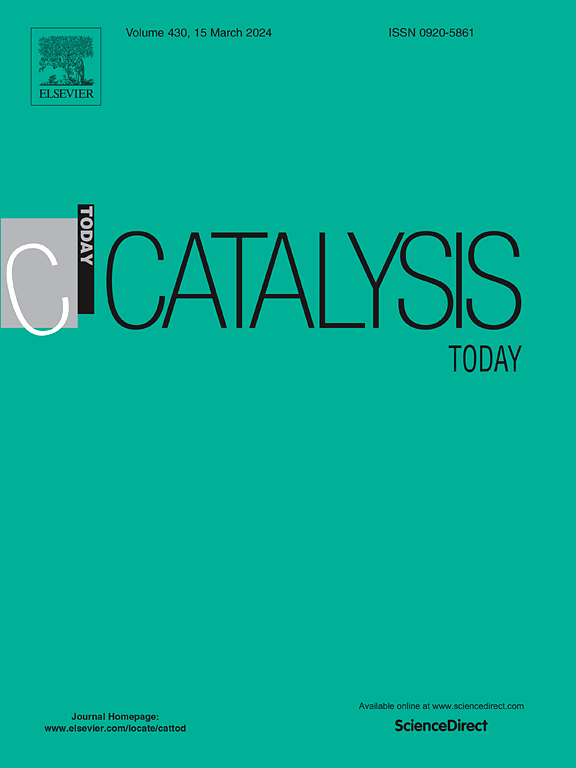考虑选择性催化剂失活的塑料热解油(PPO)和真空汽油(VGO)共混加氢过程的六块动力学模型
IF 5.2
2区 化学
Q1 CHEMISTRY, APPLIED
引用次数: 0
摘要
采用NiW/HY催化剂,建立了真空气油(VGO)和塑料热解油(PPO)以90:10 wt%的比例加氢加工的六块动力学模型。该工艺旨在通过生产有价值的油馏分,如石脑油和轻循环油(LCO),使废塑料增值。实验在半连续搅拌槽式反应器中进行,温度范围为370-440℃,氢气压力为80 bar。特别注意开发模型来量化焦炭和金属(铁)沉积造成的失活效应,后者的影响较小。这些模型是基于实验验证的这些现象的机制,通过不同的死后表征技术应用于废催化剂进行研究。一个可分离的失活模型的成功拟合——每个反应块具有不同的失活函数和与焦炭含量相关的活度函数——突出了焦炭沉积造成的孔阻塞的重大影响。这种阻断选择性地影响分子在不同肿块内的扩散,这取决于它们的体积。结果表明,提高温度对石脑油和LCO馏分的收率都有有利的影响。在440°C和180 min下,这些团块的产率超过70 wt%,转化率大于75 %。值得注意的是,在这个升高的温度下,焦炭组分的加氢裂化变得更加有利,减轻了由焦炭沉积引起的失活。本文章由计算机程序翻译,如有差异,请以英文原文为准。
Six-lump kinetic model for plastic pyrolysis oil (PPO) and vacuum gasoil (VGO) blend hydroprocessing considering selective catalyst deactivation
A six-lump kinetic model has been developed for the hydroprocessing of a mixture of vacuum gas oil (VGO) and plastic pyrolysis oil (PPO) in a ratio of 90:10 wt%, using a NiW/HY catalyst. This process aims to valorize waste plastics by producing valuable oil fractions such as naphtha and light cycle oil (LCO). The experiments were conducted in a semi-continuous stirred tank reactor across a temperature range of 370–440 °C and under 80 bar hydrogen pressure. Special attention was given on developing models to quantify the deactivation effects caused by coke and metal (Fe) deposition, with the latter having a lesser impact. These models are based on experimentally validated mechanisms of these phenomena, investigated through different post-mortem characterization techniques applied to spent catalysts. The successful fit of a separable deactivation model –featuring different deactivation functions for each reaction lump and an activity function related to the coke content– highlights the significant impact of pore blocking due to coke deposition. This blocking selectively affects the diffusion of molecules within the different lumps, depending on their volume. The results indicate that increasing the temperature has a favorable effect on the yield of naphtha and LCO fractions. At 440 °C and 180 min, the yield of these lumps exceeds 70 wt%, with a conversion greater than 75 %. Notably, at this elevated temperature, the hydrocracking of coke components becomes more favorable mitigating the deactivation caused by coke deposition.
求助全文
通过发布文献求助,成功后即可免费获取论文全文。
去求助
来源期刊

Catalysis Today
化学-工程:化工
CiteScore
11.50
自引率
3.80%
发文量
573
审稿时长
2.9 months
期刊介绍:
Catalysis Today focuses on the rapid publication of original invited papers devoted to currently important topics in catalysis and related subjects. The journal only publishes special issues (Proposing a Catalysis Today Special Issue), each of which is supervised by Guest Editors who recruit individual papers and oversee the peer review process. Catalysis Today offers researchers in the field of catalysis in-depth overviews of topical issues.
Both fundamental and applied aspects of catalysis are covered. Subjects such as catalysis of immobilized organometallic and biocatalytic systems are welcome. Subjects related to catalysis such as experimental techniques, adsorption, process technology, synthesis, in situ characterization, computational, theoretical modeling, imaging and others are included if there is a clear relationship to catalysis.
 求助内容:
求助内容: 应助结果提醒方式:
应助结果提醒方式:


